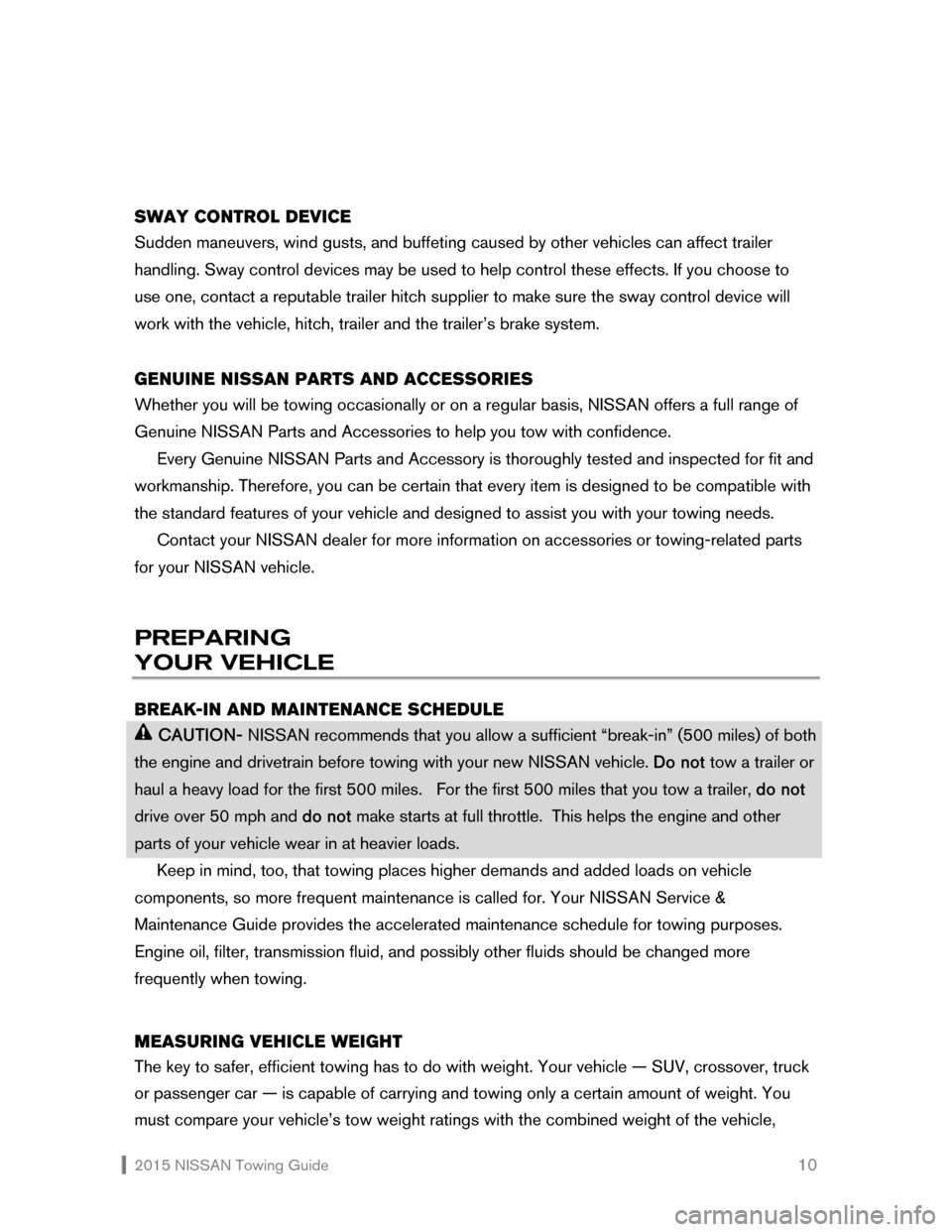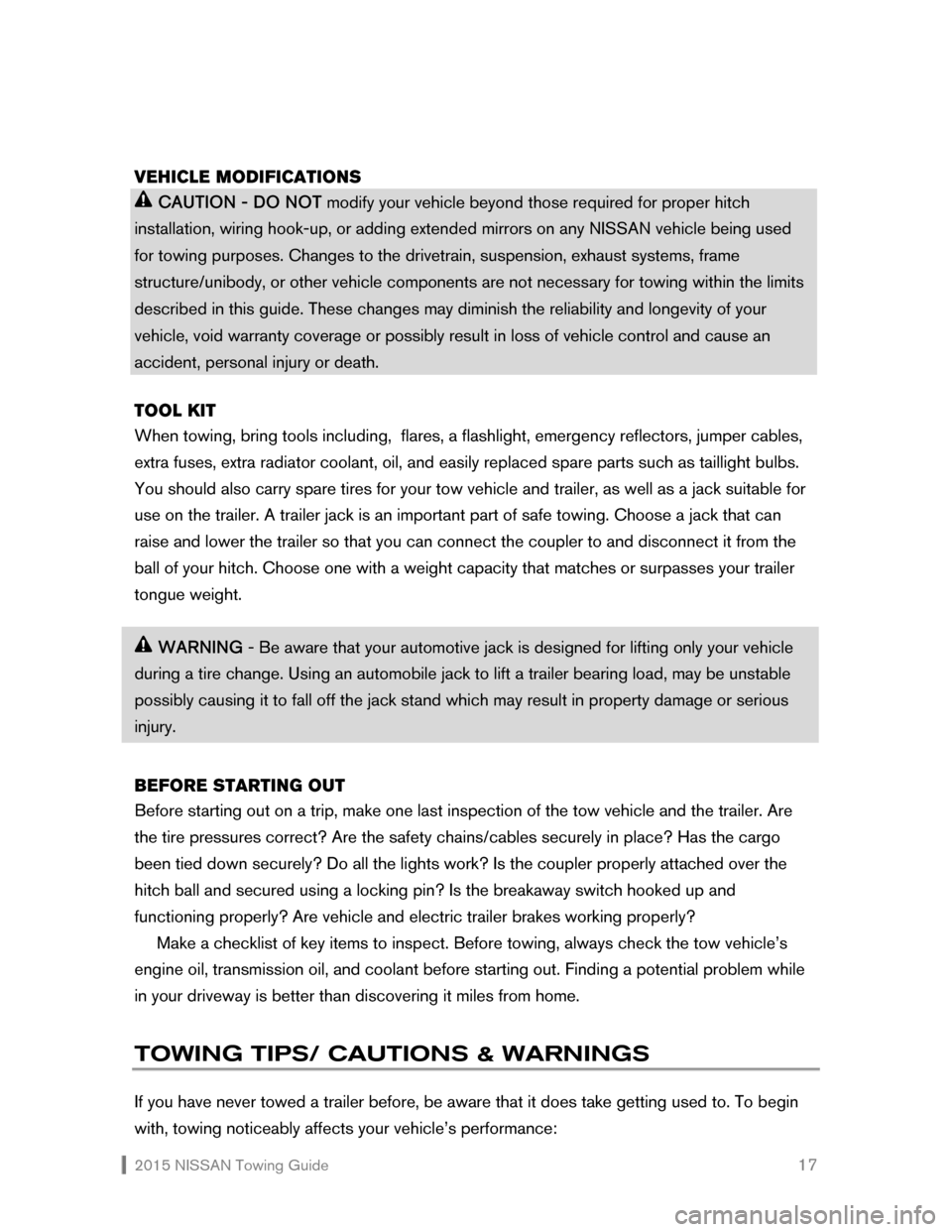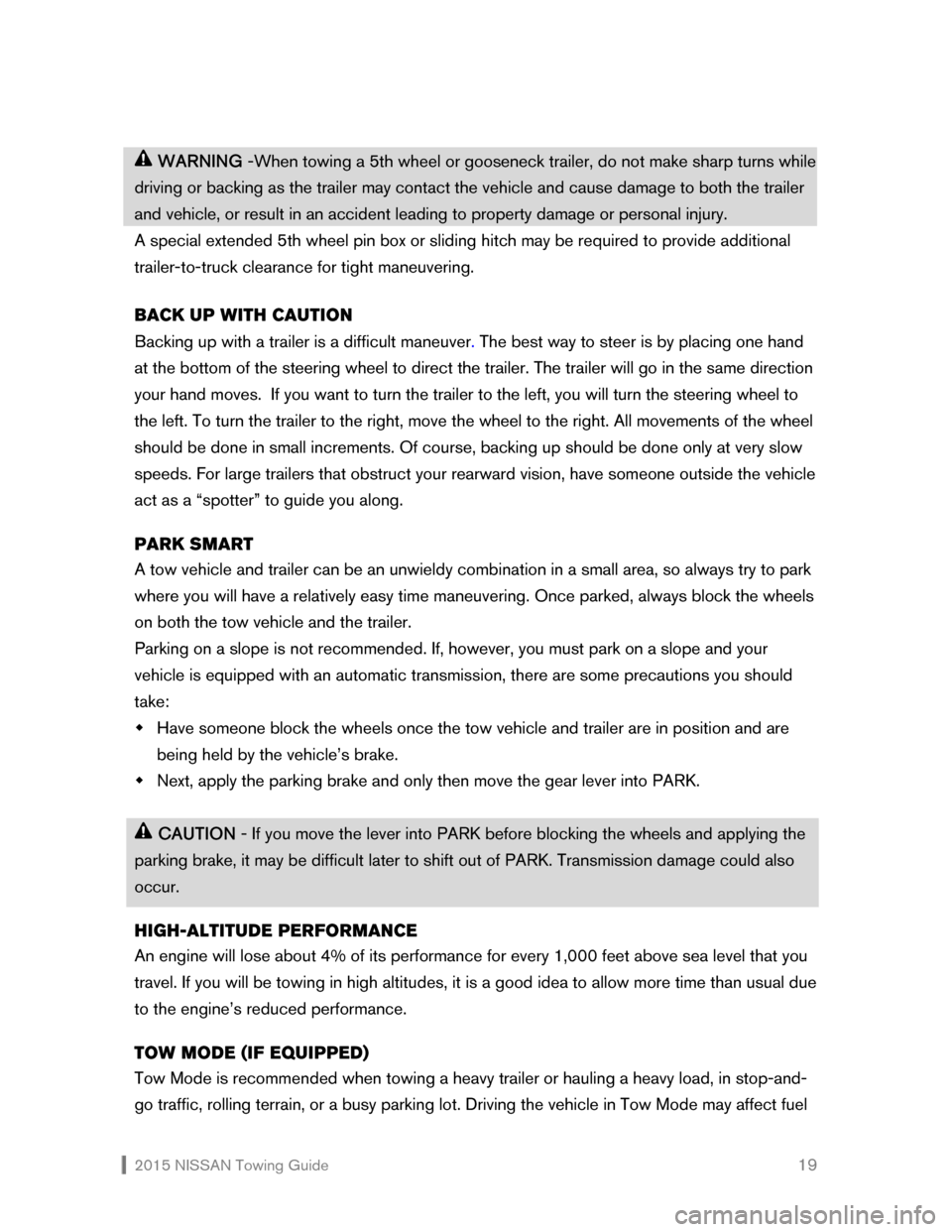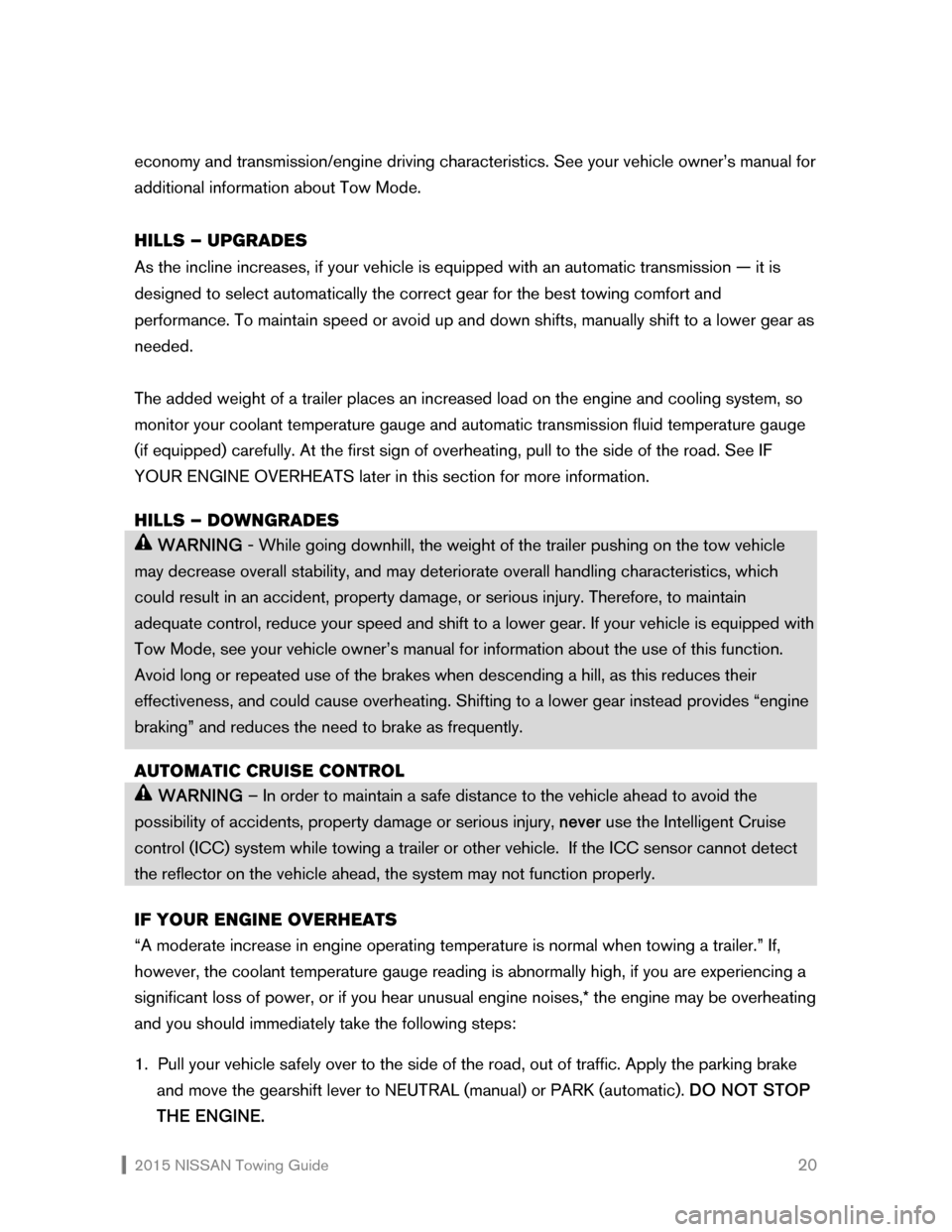2015 NISSAN ROGUE transmission
[x] Cancel search: transmissionPage 2 of 27

2015 NISSAN Towing Guide 1
INTRODUCTION
SAFETY IS PRIORITY ONE
Obviously, your first concern should be safety. Your vehicle was designed to be used primarily
to carry passengers and cargo. Always remember that towing a trailer places additional loads
on your vehicle’s engine, drivetrain, suspension, steering, braking, and other systems.
Therefore, be certain that your vehicle can meet the demands of the towing application you
have in mind.
Rent or purchase towing equipment that complies with established industry standards and
state and federal safety regulations. Reinforced tow hitches designed especially for certain
NISSAN vehicles are available from your NISSAN dealer. Hitches for other NISSAN models –
If Nissan recommends towing with that vehicle - should be bought from and installed by a
professional supplier of towing equipment. Carefully review all information and literature
provided with any hitch you purchase for safety and proper use information.
Finally, it is important to follow the towing capacity limit set for your specific vehicle, and to
ensure that your vehicle is in top mechanical condition, especially the tires, brakes,
suspension, and engine cooling system. See your vehicle owner’s manual for details.
NEVER EXCEED THE ESTABLISHED TOWING CAPACITY
Towing capacities vary from vehicle to vehicle. See the towing information in your vehicle
owner’s manual to confirm whether your NISSAN vehicle can be used to tow and if so, what
its towing capacity rating is. Use this data to help select the proper NISSAN vehicle to meet
your anticipated towing needs, and refer to it when renting a trailer or other piece of towing
equipment.
EQUIP YOUR NISSAN FOR TOWING
The frequency and type of towing dictate the manner in which you equip your vehicle. If you
plan to tow often, for either recreation or work, select the engine size, transmission type,
suspension, and towing capacity that are best suited to your requirements. This guide can
help you select that equipment.
If, on the other hand, your towing will be infrequent, choose the NISSAN vehicle and
equipment that best meets your day-to-day needs. Be careful not to exceed the towing
capacity on those few occasions when you do tow.
READ THIS GUIDE BEFORE YOU TOW
This guide was designed to provide an overview of safe towing practices. Here, you will find
information on towing equipment, safety, proper loading and driving techniques, towing tips,
and much more.
Page 11 of 27

2015 NISSAN Towing Guide 10
SWAY CONTROL DEVICE
Sudden maneuvers, wind gusts, and buffeting caused by other vehicles can affect trailer
handling. Sway control devices may be used to help control these effects. If you choose to
use one, contact a reputable trailer hitch supplier to make sure the sway control device will
work with the vehicle, hitch, trailer and the trailer’s brake system.
GENUINE NISSAN PARTS AND ACCESSORIES
Whether you will be towing occasionally or on a regular basis, NISSAN offers a full range of
Genuine NISSAN Parts and Accessories to help you tow with confidence.
Every Genuine NISSAN Parts and Accessory is thoroughly tested and inspected for fit and
workmanship. Therefore, you can be certain that every item is designed to be compatible with
the standard features of your vehicle and designed to assist you with your towing needs.
Contact your NISSAN dealer for more information on accessories or towing-related parts
for your NISSAN vehicle.
PREPARING
YOUR VEHICLE
BREAK-IN AND MAINTENANCE SCHEDULE
CAUTION- NISSAN recommends that you allow a sufficient “break-in” (500 miles) of both
the engine and drivetrain before towing with your new NISSAN vehicle. Do not tow a trailer or
haul a heavy load for the first 500 miles. For the first 500 miles that you tow a trailer, do not
drive over 50 mph and do not make starts at full throttle. This helps the engine and other
parts of your vehicle wear in at heavier loads.
Keep in mind, too, that towing places higher demands and added loads on vehicle
components, so more frequent maintenance is called for. Your NISSAN Service &
Maintenance Guide provides the accelerated maintenance schedule for towing purposes.
Engine oil, filter, transmission fluid, and possibly other fluids should be changed more
frequently when towing.
MEASURING VEHICLE WEIGHT
The key to safer, efficient towing has to do with weight. Your vehicle — SUV, crossover, truck
or passenger car — is capable of carrying and towing only a certain amount of weight. You
must compare your vehicle’s tow weight ratings with the combined weight of the vehicle,
Page 18 of 27

2015 NISSAN Towing Guide 17
VEHICLE MODIFICATIONS
CAUTION - DO NOT modify your vehicle beyond those required for proper hitch
installation, wiring hook-up, or adding extended mirrors on any NISSAN vehicle being used
for towing purposes. Changes to the drivetrain, suspension, exhaust systems, frame
structure/unibody, or other vehicle components are not necessary for towing within the limits
described in this guide. These changes may diminish the reliability and longevity of your
vehicle, void warranty coverage or possibly result in loss of vehicle control and cause an
accident, personal injury or death.
TOOL KIT
When towing, bring tools including, flares, a flashlight, emergency reflectors, jumper cables,
extra fuses, extra radiator coolant, oil, and easily replaced spare parts such as taillight bulbs.
You should also carry spare tires for your tow vehicle and trailer, as well as a jack suitable for
use on the trailer. A trailer jack is an important part of safe towing. Choose a jack that can
raise and lower the trailer so that you can connect the coupler to and disconnect it from the
ball of your hitch. Choose one with a weight capacity that matches or surpasses your trailer
tongue weight.
WARNING - Be aware that your automotive jack is designed for lifting only your vehicle
during a tire change. Using an automobile jack to lift a trailer bearing load, may be unstable
possibly causing it to fall off the jack stand which may result in property damage or serious
injury.
BEFORE STARTING OUT
Before starting out on a trip, make one last inspection of the tow vehicle and the trailer. Are
the tire pressures correct? Are the safety chains/cables securely in place? Has the cargo
been tied down securely? Do all the lights work? Is the coupler properly attached over the
hitch ball and secured using a locking pin? Is the breakaway switch hooked up and
functioning properly? Are vehicle and electric trailer brakes working properly?
Make a checklist of key items to inspect. Before towing, always check the tow vehicle’s
engine oil, transmission oil, and coolant before starting out. Finding a potential problem while
in your driveway is better than discovering it miles from home.
TOWING TIPS/ CAUTIONS & WARNINGS
If you have never towed a trailer before, be aware that it does take getting used to. To begin
with, towing noticeably affects your vehicle’s performance:
Page 20 of 27

2015 NISSAN Towing Guide 19
WARNING -When towing a 5th wheel or gooseneck trailer, do not make sharp turns while
driving or backing as the trailer may contact the vehicle and cause damage to both the trailer
and vehicle, or result in an accident leading to property damage or personal injury.
A special extended 5th wheel pin box or sliding hitch may be required to provide additional
trailer-to-truck clearance for tight maneuvering.
BACK UP WITH CAUTION
Backing up with a trailer is a difficult maneuver. The best way to steer is by placing one hand
at the bottom of the steering wheel to direct the trailer. The trailer will go in the same direction
your hand moves. If you want to turn the trailer to the left, you will turn the steering wheel to
the left. To turn the trailer to the right, move the wheel to the right. All movements of the wheel
should be done in small increments. Of course, backing up should be done only at very slow
speeds. For large trailers that obstruct your rearward vision, have someone outside the vehicle
act as a “spotter” to guide you along.
PARK SMART
A tow vehicle and trailer can be an unwieldy combination in a small area, so always try to park
where you will have a relatively easy time maneuvering. Once parked, always block the wheels
on both the tow vehicle and the trailer.
Parking on a slope is not recommended. If, however, you must park on a slope and your
vehicle is equipped with an automatic transmission, there are some precautions you should
take:
Have someone block the wheels once the tow vehicle and trailer are in position and are
being held by the vehicle’s brake.
Next, apply the parking brake and only then move the gear lever into PARK.
CAUTION - If you move the lever into PARK before blocking the wheels and applying the
parking brake, it may be difficult later to shift out of PARK. Transmission damage could also
occur.
HIGH-ALTITUDE PERFORMANCE
An engine will lose about 4% of its performance for every 1,000 feet above sea level that you
travel. If you will be towing in high altitudes, it is a good idea to allow more time than usual due
to the engine’s reduced performance.
TOW MODE (IF EQUIPPED)
Tow Mode is recommended when towing a heavy trailer or hauling a heavy load, in stop-and-
go traffic, rolling terrain, or a busy parking lot. Driving the vehicle in Tow Mode may affect fuel
Page 21 of 27

2015 NISSAN Towing Guide 20
economy and transmission/engine driving characteristics. See your vehicle owner’s manual for
additional information about Tow Mode.
HILLS – UPGRADES
As the incline increases, if your vehicle is equipped with an automatic transmission — it is
designed to select automatically the correct gear for the best towing comfort and
performance. To maintain speed or avoid up and down shifts, manually shift to a lower gear as
needed.
The added weight of a trailer places an increased load on the engine and cooling system, so
monitor your coolant temperature gauge and automatic transmission fluid temperature gauge
(if equipped) carefully. At the first sign of overheating, pull to the side of the road. See IF
YOUR ENGINE OVERHEATS later in this section for more information.
HILLS – DOWNGRADES
WARNING - While going downhill, the weight of the trailer pushing on the tow vehicle
may decrease overall stability, and may deteriorate overall handling characteristics, which
could result in an accident, property damage, or serious injury. Therefore, to maintain
adequate control, reduce your speed and shift to a lower gear. If your vehicle is equipped with
Tow Mode, see your vehicle owner’s manual for information about the use of this function.
Avoid long or repeated use of the brakes when descending a hill, as this reduces their
effectiveness, and could cause overheating. Shifting to a lower gear instead provides “engine
braking” and reduces the need to brake as frequently.
AUTOMATIC CRUISE CONTROL
WARNING – In order to maintain a safe distance to the vehicle ahead to avoid the
possibility of accidents, property damage or serious injury, never use the Intelligent Cruise
control (ICC) system while towing a trailer or other vehicle. If the ICC sensor cannot detect
the reflector on the vehicle ahead, the system may not function properly.
IF YOUR ENGINE OVERHEATS
“A moderate increase in engine operating temperature is normal when towing a trailer.” If,
however, the coolant temperature gauge reading is abnormally high, if you are experiencing a
significant loss of power, or if you hear unusual engine noises,* the engine may be overheating
and you should immediately take the following steps:
1. Pull your vehicle safely over to the side of the road, out of traffic. Apply the parking brake
and move the gearshift lever to NEUTRAL (manual) or PARK (automatic). DO NOT STOP
THE ENGINE.